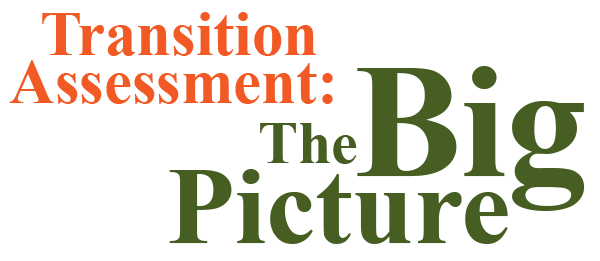Transition assessment is a cornerstone of the transition planning process. Planning for transition is all about working with students and families to identify where a student excels, where they are interested in heading in their future, and what additional or ongoing support is needed. Transition assessment embodies many different methods and approaches. The exercise below will clear up a few …
Transition Assessment: The Big Picture
Why assess students with disabilities during transition planning?Every day, educators assess students for purposes of tracking progress, targeting areas for improvement, and providing feedback; however, secondary educators may not consider the comprehensive value of transition assessment. The Individuals with Disabilities Act (IDEA (2004)) requires that postsecondary goals be “based upon age-appropriate transition assessments related to training, education, employment, and, where …
Instruction in Self-Advocacy
Self-advocacy skills relate to a student’s ability to effectively communicate, convey, and/or assert their own interests and desires. Self-advocacy activities and experiences help students develop: Communication skills Leadership skills Knowledge of self Knowledge of rights and responsibilities Click on the links below to learn more about Individual and Group Self-Advocacy Services.Individual Self-Advocacy Services Learn about the unique support needs of …
Stages of Collaboration
One way to keep your interagency team moving forward is to consider the group’s current stage of collaboration and identify areas in which the group can work more collaboratively. Interagency collaboration can vary from one team to the next, as it is often developmental: teams move through different stages before achieving high rates of collaboration. A team’s stage of collaboration …
Families as Key Players
Typically, families are the constant in students’ lives. Consider the broadest definition of a family’s culture – the knowledge, concepts and values shared by family members 7(Barrera & Corso, 2005). This will help expand how cultural diversity of families should be represented on interagency teams. Families are more involved when schools invite and support them to participate. Watch This Dr. …
Meet Olivia Clark
Olivia Clark is 19 years old. Home and school life She is currently enrolled in the district’s community-based transition program located at a small community college in her town. She can stay enrolled in this program until she turns 21 years old. She lives with her mom and two siblings in a rural community. Her mom has supported the family …
Summary
This mini-module guides you through six critical elements of high-quality community-based transition programs leading to successful post-school outcomes. A quick summary of these elements: 1.Inclusion Students are included with same-age peers across all elements of the program. 2.Paid Integrated Employment Experience CBTP’s prioritize students’ integrated experiences in the community, and especially paid work. 3.Self-Determination Students are supported to practice having …
7. Family Engagement and Expectations
Families are an important part of a student’s development. Traditional, non-traditional, biological, foster, or adoptive families provide support throughout students’ lives, including during the transition to adulthood. Families can provide high expectations for their young adult to be successful in a CBTP, especially by envisioning inclusive adult outcomes. Families can also provide instrumental and emotional supports and resources to facilitate …
1. Inclusive Settings
Given what we know about inclusive experiences, CBTPs should be located where students have access to same-aged peers. For students between 18-21 years old, the most likely setting is postsecondary campuses (e.g., universities and colleges, community college, technical school, adult learning centers, etc). Many districts have started to develop dual enrollment programs where students still being served through IDEA transition …
Summary
Transition planning predicated on specific requirements in IDEA that target an outcome-oriented process. Transition planning requires families and professionals to think and act differently as a student ages. Effective and meaningful transition planning involves the student, the family, school staff, and oftentimes community members and agencies. How others are involved during transition process and providing services may make a significant …

